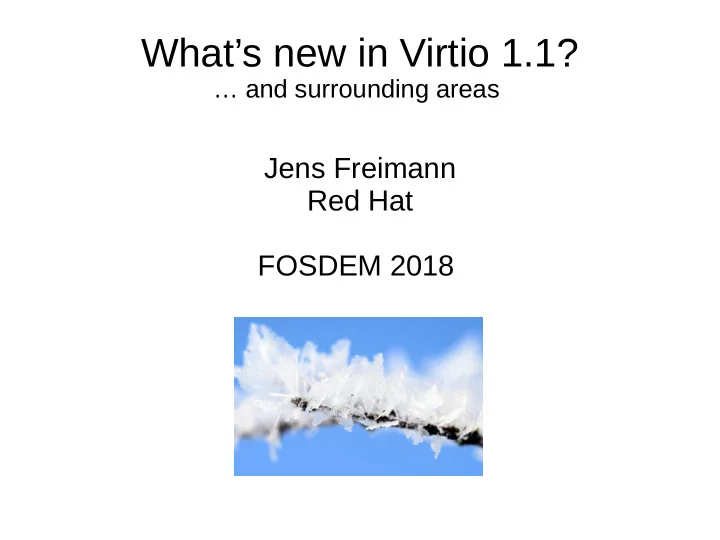

What’s new in Virtio 1.1? … and surrounding areas Jens Freimann Red Hat FOSDEM 2018
What is Virtio? ● Easy mechanism to provide virtual devices to guests – Disk, net, gpu, ... ● Standard driver means compatibility across hypervisors and operating systems “The purpose of VIRTIO is to ensure that virtual environments and guests have a straightforward, efficient, standard, and extensible mechanism for virtual devices, rather than boutique per-environment or per-OS mechanisms.”
Virtio and NFV
Virtio components Device types net blk ... Feature bits Config space Virtqueues Core PCI CCW MMIO Transport
Virtio components Device types net blk ... Virtqueues Feature bits Config space Core PCI CCW MMIO Transport
Packed Virtqueues ● Motivation – Make it easier to implement virtio in hardware – Performance gains ● Optimize ring layout
Split virtqueue Descriptor (addr, len, next) Avail idx Used idx Available Used ring ring Avail ring head Located in shared memory ● Host and guest using ● shared memory to pass messages Possibly on different CPUs ● Causing cache ● synchronization
Split virtqueue Descriptor (addr, len, next) buffer Avail idx Used idx Available Used ring ring Avail ring head Located in shared memory ● Host and guest using ● shared memory to pass messages Possibly on different CPUs ● Causing cache ● synchronization
Reducing the overhead ● Information is spread across too many data structures ● Tighter packing will save cache misses. ● How about packing everything in a single data structure? 9
Descriptor ring ● Driver writes out available descriptors in a ring ● Device writes out used descriptors in the same ring ● Descriptor: addr, len, avail, used ● To mark a descriptor available, flip the avail bit ● To mark a descriptor as used, flip the used bit 10
Descriptor states Driver Available wrap counter = 0 Write desc, set flags Avail=1, Used=0 1 0 1 0 Device Write desc, set flags Avail=0, Used=0 Used wrap counter = 0 11
Descriptor states Driver Available wrap counter = 1 Ring wraps around Write desc, set flags Avail= 0 , Used= 1 0 1 0 1 Device Write desc, set flags Avail= 1 , Used= 1 Used wrap counter = 1 12
Performance ● PVP test setup as described in http://www.dpdk.org/doc/guides/howto/pvp_reference_ben chmark.html ● CPU: Intel(R) Xeon(R) CPU E5-2667 v4 @ 3.20GHz ● Host and Guest: RHEL 7.4 ● Packet generator: T-REX ● Acceptable loss: 0.05% ● DPDK v17.11 ● Patches at https://github.com/jensfr/dpdk/tree/virtio-1.1-v1 13
Performance – 64 byte packet throughput 23 22 21 20 virtio 1.0 virtio 1.1 19 18 17 16 Mpps 14
Participate in Virtio ● git clone https://github.com/oasis-tcs/virtio-spec Edit :) ● sh makeall.sh (needs xelatex, e.g. from texlive) ● virtio-comment-subscribe@lists.oasis-open.org ● Patch: virtio-comment@lists.oasis-open.org ● If no comments – email, ask for a vote ballot ● Total time: up to 2 weeks 15
Participate in Virtio ● git clone https://github.com/oasis-tcs/virtio-spec Edit :) ● sh makeall.sh (needs xelatex, e.g. from texlive) ● virtio-comment-subscribe@lists.oasis-open.org ● Patch: virtio-comment@lists.oasis-open.org ● If no comments – email, ask for a vote ballot ● Total time: up to 2 weeks 16
vDPA – virtual Datapath Accelerator https://events.static.linuxfound.org/sites/events/files/slides/KVM17%27- vDPA.pdf 17
vDPA – virtual Datapath Accelerator https://events.static.linuxfound.org/sites/events/files/slides/KVM17%27- vDPA.pdf 18
vDPA – virtual Datapath Accelerator https://events.static.linuxfound.org/sites/events/files/slides/KVM17%27- vDPA.pdf 19
Vhost-pci – Fast VM-to-VM communication http://www.linux-kvm.org/images/5/55/02x07A-Wei_Wang-Design_of-Vhost-pci.pdf 20
Vhost-pci – Fast VM-to-VM communication http://www.linux-kvm.org/images/5/55/02x07A-Wei_Wang-Design_of-Vhost-pci.pdf 21
virtio-vhost-user ● Slightly different approach to vhost-pci but same goal ● Lets guests act as vhost device backends – Virtual network appliances can provide virtio devices to other guests – Provide high-performance vhost-user appliances to other guests in the same cloud environment ● Exitless fast VM-to-VM communication – With poll mode drivers, even with interrupts fast because of ioeventfds https://wiki.qemu.org/Features/VirtioVhostUser 22
virtio-vhost-user VM 2 VM 1 vhost virtio-net device backend virtio- vhost-user vhost-user QEMU QEMU https://wiki.qemu.org/Features/VirtioVhostUser 23
virtio-vhost-user VM 2 VM 1 vhost virtio-net device backend virtio- vhost-user vhost-user QEMU QEMU https://wiki.qemu.org/Features/VirtioVhostUser 24
Transparent bonding for SR-IOV devices ● Bond a virtio device and a SR-IOV device – When virtio and SR-IOV drivers load, look for other NIC that matches MAC address – Enslave NIC and bring up the slave ● Switch over to virtio device before migration – Link of SR-IOV device goes down ● On target system switch back to SR-IOV device (if available, virtio as fallback) 25
Conclusion ● Virtio 1.1 will be a big release, focus on – Performance – Hardware implementation – DPDK implemenation of packed virtqueues: <insert link> – There is a monthly DPDK Virtio meeting where we discuss progress, let me know if you’d like to join. jfreimann@redhat.com 26
Questions? jfreimann@redhat.com 27
Recommend
More recommend